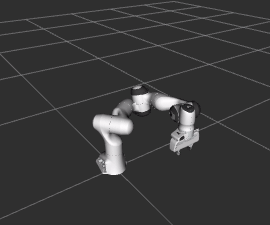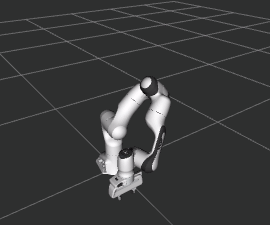Tutorial: Instant-Use Move Behaviours with PyTrees
This tutorials illustrates examples of using the move behaviour classes for building behaviour trees based on py-tree.
This demo requires the Panda robot model.
Running the Demo Program
Assume that the task trees and the arm commander packages are installed in a catkin_workspace. Refer to the Installation Guide
Change directory to the root of the catkin workspace, run
source devel/setup.bash.Change directory to this demo folder, run one of the demo programs such as
/usr/bin/python3 simple_move_1.py.
Example 1: The Minimal Program
The program simple_move_1.py illustrates a small program that build the simplest behaviour tree and populate it with a move behaviour class.
The following is the common constructor for the series of demo programs. It setups the arm commander, creates a branch and stick the branch to a py-tree BehaviourTree object. It finally creates a new thread to run the behaviour tree.
...
def __init__(self, arm_commander:GeneralCommander, spin_period_ms:int=10):
# setup the robotic manipulation platform through the commander
self.arm_commander:GeneralCommander = arm_commander
self.arm_commander.abort_move(wait=True)
self.arm_commander.reset_world()
self.arm_commander.wait_for_ready_to_move()
# build the behaviour tree
self.root_sequence = self.create_move_branch() ##### populate the branch
self.bt = BehaviourTree(self.root_sequence)
py_trees.display.render_dot_tree(self.bt.root)
# spin the tree
self.the_thread = threading.Thread(target=lambda: self.bt.tick_tock(period_ms=spin_period_ms), daemon=True)
self.the_thread.start()
The function create_move_branch is given below, which creates a Sequence of one behaviour.
def create_move_branch(self) -> Composite:
move_branch = py_trees.composites.Sequence(
'move_branch',
memory=True,
children=[
DoMoveXYZ('move_xyz', True, arm_commander=self.arm_commander, target_xyz=[0.3, 0.0, 0.6]),
],
)
return move_branch
It passes a constant to the target_xyz parameter, which moves the end-effector to xyz = [0.3, 0.0, 0.6] in the default reference frame.
Example 2: Two Behaviours in a Sequence
The program simple_move_2.py defines a sequence with two behaviours.
def create_move_branch(self) -> Composite:
move_branch = py_trees.composites.Sequence(
'move_branch',
memory=True,
children=[
DoMoveXYZ('move_xyz', True, arm_commander=self.arm_commander, target_xyz=[0.3, 0.0, 0.2]),
DoMoveXYZ('move_xyz', True, arm_commander=self.arm_commander, target_xyz=[0.3, 0.0, 0.6]),
],)
return move_branch

Example 3: Late Binding of the Target XYZ
The program simple_move_3.py shows how the class DoMoveXYZ can accept a function so that the target xyz is determined at the tick-tock time.
def create_move_branch(self) -> Composite:
move_branch = py_trees.composites.Sequence(
'move_branch',
memory=True,
children=[
DoMoveXYZ('move_xyz', True, arm_commander=self.arm_commander, target_xyz=self.generate_random_xyz),
],)
return move_branch
The function self.generate_random_xyz is listed below. It returns a xyz list with each of the three components randomly generated.
def generate_random_xyz(self) -> list:
xyz = [random.uniform(0.1, 0.5), random.uniform(-0.3, 0.3), random.uniform(0.2, 0.6)]
logger.info(f'generate_random_xyz: {xyz}')
return xyz

Example 4: Two Sequence Branches and the class DoMoveXYZRPY
The program simple_move_4.py shows a behaviour tree with two sequence branches. It also demonstrates how separating the target position and orientation in the class DoMoveXYZRPY enables finer movement control.
The constructor has included code that creates two branches.
...
# build the behaviour tree
self.move_branch = self.create_move_branch()
self.init_branch = self.create_init_branch()
self.init_branch = py_trees.decorators.OneShot('init_oneshot_branch', policy = py_trees.common.OneShotPolicy.ON_COMPLETION, child=self.init_branch)
self.root_sequence = py_trees.composites.Sequence('root_sequence', memory=True, children=[
self.init_branch,
self.move_branch,
])
The function create_init_branch.
def create_init_branch(self) -> Composite:
init_branch = py_trees.composites.Sequence(
'init_branch',
memory=True,
children=[
DoMoveXYZRPY('reset_pose', True, arm_commander=self.arm_commander, target_xyz=[0.307, 0.0, 0.588],
target_rpy=[3.139, 0.0, -0.785]),
],)
return init_branch
The function create_move_branch. Note that the parameter target_xyz is a compositional list. The first value specifies only x = 0.3 but leaves the y and z open. The second value provides a random y and a random z. The x component of the second value is ignored because x is already specified by the first value.
def create_move_branch(self) -> Composite:
move_branch = py_trees.composites.Sequence(
'move_branch',
memory=True,
children=[
DoMoveXYZRPY('move_xyzrpy', True, arm_commander=self.arm_commander,
target_xyz=[[0.3, None, None], self.generate_random_xyz],
target_rpy=self.generate_random_rpy),
],
)
return move_branch
The following table explains the composition of the parameter target_xyz.
The Rank |
The Value |
Composition of the Target XYZ |
Remarks |
|---|---|---|---|
0 |
|
||
1 |
|
|
|
2 |
self.generate_random_xyz |
|
Assume the function returns [rx, ry, rz] |

Example 5: More Complex Trees and the class DoMoveDisplaceXYZ
The program simple_move_5.py shows a more complex move branch, which utilizes also the Repeat decorator from py-trees. It defines a movement along the four sides of a rectangle. The sequence is moving right, up, left, and down, each side is divided into 5 steps.
def create_move_branch(self) -> Composite:
move_branch = py_trees.composites.Sequence(
'move_branch',
memory=True,
children=[
py_trees.decorators.Repeat('repeat_move_dy', child=DoMoveDisplaceXYZ('move_dy', True, arm_commander=self.arm_commander, dxyz=[0.0, 0.05, 0]),
num_success=5),
py_trees.decorators.Repeat('repeat_move_dz', child=DoMoveDisplaceXYZ('move_dz', True, arm_commander=self.arm_commander, dxyz=[0, 0, 0.05]),
num_success=5),
py_trees.decorators.Repeat('repeat_move_ndy', child=DoMoveDisplaceXYZ('move_ndy', True, arm_commander=self.arm_commander, dxyz=[0, -0.05, 0]),
num_success=5),
py_trees.decorators.Repeat('repeat_move_ndz', child=DoMoveDisplaceXYZ('move_random_ndz', True, arm_commander=self.arm_commander, dxyz=self.generate_random_dxyz),
num_success=5),
],
)
return move_branch

Example 6: Two Behaviours in a Sequence using DoMovePose
The program simple_move_6.py defines a sequence with two behaviours using DoMovePose, with which both position and rotation can be specified.
def create_move_branch(self) -> Composite:
move_branch = py_trees.composites.Sequence(
'move_branch',
memory=True,
children=[
DoMovePose('move_xyzrpy', True, arm_commander=self.arm_commander, target_pose=[0.5, 0.0, 0.2, 3.14, 0, 1.58]),
DoMovePose('move_xyzrpy', True, arm_commander=self.arm_commander, target_pose=[0.5, 0.0, 0.5, 3.14, 0.2, 0]),
],)
return move_branch
Example 7: Late Binding of the Target Pose in DoMovePose
The program simple_move_7.py shows how the class DoMovePose can accept a function so that the target pose is determined at the tick-tock time. In this example, the target pose is based on the current pose with a random component from (x, y, z, yaw) changed by a random value.
def create_move_branch(self) -> Composite:
move_branch = py_trees.composites.Sequence(
'move_branch',
memory=True,
children=[
DoMovePose('move_random_step', True, arm_commander=self.arm_commander, target_pose=self.generate_random_move),
],)
return move_branch
The function self.generate_random_move is listed below. It obtains the current pose in xyzrpy format and then
def generate_random_move(self) -> list:
xyzrpy = self.arm_commander.pose_in_frame_as_xyzrpy()
which_dim = random.randint(0, 4)
if which_dim in [0, 1, 2]:
xyzrpy[which_dim] += random.uniform(-0.2, 0.2) # the x, y, or z component
elif which_dim == 3:
xyzrpy[5] += random.uniform(-1.57, 1.57) # the yaw component
logger.info(f'generate_random_move: {xyzrpy}')
return xyzrpy